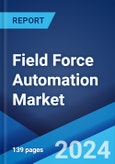Field force automation (FFA) is an advanced software designed to establish bi-directional information flow regarding sales and service in real-time through employing communication technologies. It enables technicians and head office staff to utilize handheld wireless devices for capturing and transferring data immediately in the back-end accounting systems to eliminate the time spent on manual data and eradicate errors associated with the entry. FFA offers data-driven efficiency, streamlines operations, tracks field executive performance via gaining better visibility, provides better customer experience, and automates diverse business operations. This, in turn, helps organizations make informed decisions, improve operational execution and compliance, ensure easier onboarding, and drive productivity in the respective field. As a result, FFA is extensively used by end users for enterprise resource planning (ERP), resolving communication challenges, and efficient workforce and logistics management.
Field Force Automation (FFA) Market Trends:
The widespread adoption of FFA across various industrial verticals due to the increasing need for robust and automated solutions to streamline diverse operations and maximize the field force efficiency represents one of the prime factors driving the market growth. Additionally, the extensive FFA usage to perform automatic schedules, ensure attendance management, monitor the workforce, and cater to geographically dispersed customers is acting as another growth-inducing factor. In line with this, significant improvements in the information technology (IT) sector and the growing penetration of several internet-enabled connected devices with cloud solutions are supporting the market growth. The market is also driven by the trend of bring your own device (BYOD) within enterprises. Moreover, the emergence of advanced analytics and mobile-based sales force automation software and the large-scale integration of artificial intelligence (AI) solutions are favoring the market growth. These technologies help generate accurate reports-based insights, forecast past sales through data analysis, ensure customer relationship management (CRM), and increase overall workflow. Furthermore, the escalating product employment in the fast-moving consumer goods (FMCG) sector, owing to its various advantages, including enhanced stock tracking, easy distribution, better sales strategy, and effective sales order management, is propelling the market growth. Apart from this, rapid digitalization, fueling utilization of electronic gadgets, and strategic collaborations amongst key players to engineer products with improved attributes are positively impacting the market growth.Key Market Segmentation:
The publisher provides an analysis of the key trends in each segment of the market, along with forecasts at the global, regional, and country levels for 2025-2033. Our report has categorized the market based on component, deployment mode, organization size, and industry verticals.Component Insights:
- Solution
- Service
Deployment Mode Insights:
- Cloud-based
- On-premises
Organization Size Insights:
- Large Enterprises
- Small and Medium-sized Enterprises
Industry Verticals Insights:
- IT and Telecom
- Healthcare and Life Sciences
- Manufacturing
- Transportation and Logistics
- Construction and Real Estate
- Energy and Utilities
- Others
Regional Insights:
- North America
- United States
- Canada
- Asia Pacific
- China
- Japan
- India
- South Korea
- Australia
- Indonesia
- Others
- Europe
- Germany
- France
- United Kingdom
- Italy
- Spain
- Russia
- Others
- Latin America
- Brazil
- Mexico
- Others
- Middle East and Africa
Competitive Landscape:
The report has also provided a comprehensive analysis of the competitive landscape in the global field force automation market. Detailed profiles of all major companies have also been provided. Some of the companies covered include Accruent LLC (Fortive Corporation), BT Group plc, Channelplay Limited, Fieldez Technologies Pvt. Ltd., Folio3 Software Inc., Infosys Limited, Kloudq Technologies Limited, Leadsquared, ServiceMax, VisitBasis Tech LLC, etc.Key Questions Answered in This Report:
- How has the global field force automation market performed so far, and how will it perform in the coming years?
- What are the drivers, restraints, and opportunities in the global field force automation market?
- What is the impact of each driver, restraint, and opportunity on the global field force automation market?
- What are the key regional markets?
- Which countries represent the most attractive field force automation market?
- What is the breakup of the market based on the component?
- Which is the most attractive component in the field force automation market?
- What is the breakup of the market based on the deployment mode?
- Which is the most attractive deployment mode in the field force automation market?
- What is the breakup of the market based on the organization size?
- Which is the most attractive organization size in the field force automation market?
- What is the breakup of the market based on the industry verticals?
- Which is the most attractive industry verticals in the field force automation market?
- What is the competitive structure of the market?
- Who are the key players/companies in the global field force automation market?
Table of Contents
Companies Mentioned
- Accruent LLC (Fortive Corporation)
- BT Group plc
- Channelplay Limited
- Fieldez Technologies Pvt. Ltd.
- Folio3 Software Inc.
- Infosys Limited
- Kloudq Technologies Limited
- Leadsquared
- ServiceMax
- VisitBasis Tech LLC
Methodology

LOADING...
Table Information
| Report Attribute | Details |
|---|---|
| No. of Pages | 145 |
| Published | March 2025 |
| Forecast Period | 2024 - 2033 |
| Estimated Market Value ( USD | $ 3 Billion |
| Forecasted Market Value ( USD | $ 11.2 Billion |
| Compound Annual Growth Rate | 15.8% |
| Regions Covered | Global |
| No. of Companies Mentioned | 10 |









